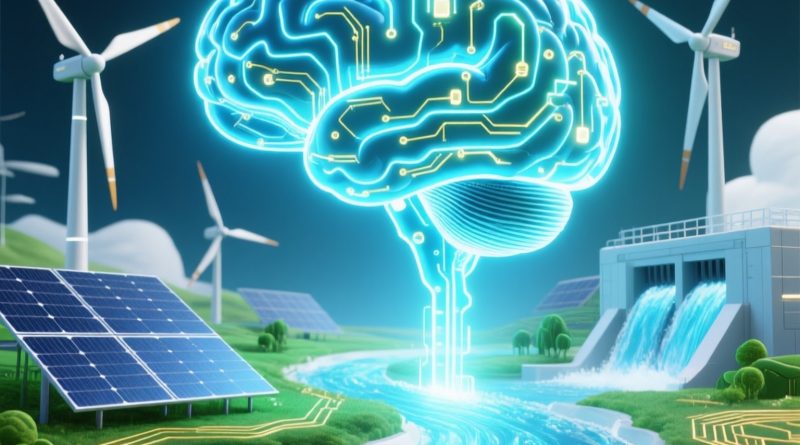The Green Revolution in Computing: Can AI Be Sustainable?
A Storm in the Server Room: A Story to Begin
Imagine a glass-fronted data centre on the outskirts of Dublin. It’s midnight. Rain batters the windows. Inside, banks of blinking servers hum softly; the temperature is controlled to within tenths of a degree. Outside, the wind turbines turn lazily on a nearby hillside. That gentle roar is drowned by the hum of cooling systems; water pumps circulate chilled fluid through racks of GPUs.
It’s one of the state-of-the-art facilities powering the world’s modern artificial intelligence. A few miles away, families sleep under low-carbon lights, oblivious that their Instagram captions might be zipping through these very racks.
Yet the electricity bills for that cold hum are immense. The water that cools those circuits flows through municipal systems. The raw materials inside the chips were mined halfway across the world. And the carbon emissions of powering the centre have become part of the invisible cost of the AI revolution.
At the same time, somewhere else in the same city, a university lab is training an AI model to predict wind-farm output. Or a startup is using machine learning to optimise traffic lights to reduce idling cars. AI is being deployed to help the planet even as it uses energy: a paradox on wheels.
This is the backdrop of The Green Revolution in Computing. The question we must now ask is: can AI be sustainable or is sustainability the price we pay for progress?
The Scale of the Problem
Before we can answer whether AI can be green, we need to understand how much it isn’t.
- According to the International Energy Agency (IEA), electricity demand from AI and data-centre workloads is rising fast, and AI is becoming a major driver of overall data-centre energy growth.
- Generative AI models, especially during training and inference, consume significantly more power than traditional computational tasks.
- Cooling is not free: data centres require water as well as electricity to regulate temperature, and that water usage has environmental cost too.
- There is also the embodied cost: the manufacture of GPUs and chips uses raw materials and energy, sometimes mined or produced in environmentally damaging ways.
In some places, like Ireland, the rapid expansion of data centres has triggered real concern about grid stability, environmental impact, and conflict over resources.
One forecast suggests that by the end of 2025 AI could account for nearly half of data-centre power usage (excluding cryptocurrency mining).
These numbers are enough to make us pause. But pause is different from giving up.
Read More: How to Build an Agentic AI for Small Tasks
Where AI Can (and Is) Helping Sustainability
Despite the heavy footprint, AI isn’t purely the problem, it may also be part of the solution. Several promising paths exist:
- Smart Cooling & Operational Efficiency
AI-driven systems already optimise cooling in data centres. By constantly monitoring temperature hotspots, airflow, and system load, they can reduce wasted cooling energy. - Predictive Energy Management
AI models can forecast renewable energy supply (e.g. when solar or wind generation is high), and shift non-critical computing tasks to when green electricity is available. This helps match energy demand to supply. - Data & Model Efficiency
Sustainability isn’t just about hardware. On the software/data side:- Reducing redundant or low-quality data before training (data-centric approaches) saves compute cycles.
- Optimising model architectures (e.g. quantization, pruning, efficient inference) reduces energy use per query.
- Lifecycle thinking: retraining less often, reusing parts of models, evaluating energy-vs-accuracy trade-offs.
- Renewable Energy & Sustainable Infrastructure
Some tech companies are powering data centres using renewables. For instance, efforts are underway by major chip-makers and cloud providers to ensure that electricity used is from low-carbon sources.
Innovations in cooling (e.g. liquid-cooling, rack-level thermal design) and facility design also contribute to lower operating costs and emissions. - Advanced Algorithms for Green Transition
More experimental approaches, such as “green AI architectures” used in resource-optimization frameworks or circular-economy designs, show promise to reduce energy per task while integrating reuse, recycling or dynamic scheduling.
These are not hypothetical; many are being prototyped or already in use. But scaling them rapidly throughout all phases from training to deployment, remains a challenge.
Key Challenges & Trade-Offs
Even with these promising directions, a sustainable AI future is not guaranteed. There are trade-offs and obstacles:
- Scale vs Efficiency: As AI becomes more powerful and widespread, its demand for compute grows. Efficiency gains may be outpaced by sheer volume of use.
- Transparency & Measurement: It’s often hard to measure exactly how much energy or how many emissions a given model or query causes. Without standard metrics or disclosure, we struggle to optimise what we don’t measure.
- Supply Constraints: Renewable energy is still constrained by geography, intermittency, grid capacity, and cost. Building more data centres in green-energy-rich regions may shift environmental burden rather than remove it.
- Hardware Lifecycle Issues: Mining, manufacturing, and disposing of hardware creates embodied carbon and waste. Extending component life and recycling is complex to engineer at scale.
- Regulation & Policy: Many national or international AI strategies focus on ethics, safety or economic benefit, fewer include strong environmental guardrails.
- User Behaviour: Even if AI infrastructure becomes more efficient, rapidly increasing usage (more queries, more users, more automation) may negate that effect unless efficiency is embedded end-to-end.

Read More: AI in Lip Reading Breaking Barriers for the Deaf and Beyond
FAQ — Frequently Asked Questions
Q: Is AI use already responsible for a large chunk of global emissions?
A: Not yet in the sense of the biggest emitters (transport, energy generation, agriculture etc.), but it is growing quickly. Some forecasts suggest data centres will more than double electricity demand by 2030 and AI workloads are a major contributor to that increase.
Q: How much energy does a single AI request use?
A: It depends on the model, the size of the query, and whether inference or training is involved. Some reports claim an AI-generated response may use many times the electricity of a simple web search.
Q: Can switching to renewable energy fully solve the problem?
A: No, it helps a great deal, especially for the operational carbon (Scope 2), but it does not address embodied emissions (the cost of building hardware) nor reduce energy needed for compute unless paired with efficiency improvements.
Q: What role do developers & data scientists have in making AI more sustainable?
A: A big one. Choices around data quality, model architecture, where to run workloads (time-of-day, location / cloud provider), quantization, pruning, reuse, and refraining from overtraining “just-in-case” models can all reduce energy consumption.
Q: Could AI itself design more sustainable AI?
A: Yes, meta-learning, AutoML or algorithmic optimisation tools could search for low-energy models, balancing performance vs energy cost. But that in turn requires oversight, transparency, and incentives to value “energy cost per inference” or “carbon per training hour” as much as accuracy or latency.
Q: What might policy makers do to encourage sustainable AI?
A: Possible levers include: regulation requiring energy reporting per model; incentives or subsidies for data centres powered by renewables; standards for “green AI” certificates; research funding into energy-efficient model design; and alignment of AI strategies with national climate goals.
Conclusion — Can AI Be Sustainable?
Yes, but only if we treat sustainability as a first-class constraint rather than an afterthought.
If we continue to build bigger models, train more often, and increase usage without regard for energy cost, AI will drive up emissions. But if researchers, engineers, policy makers and users think more holistically, optimizing data, choosing efficient models, matching compute to renewable energy availability, recycling hardware, and measuring impact transparently, then AI can evolve in harmony with climate goals rather than in conflict.
In short, AI can be sustainable, but it demands mindset change, architectural innovation, and systems thinking at every level. The green revolution in computing is not a single technology shift. It’s a transformation of how we think about computing itself: from raw power to responsible power.





Pingback: Quantum Is Coming: How to Future-Proof Your Career (and Your Code) - Latest AI/Tech Info